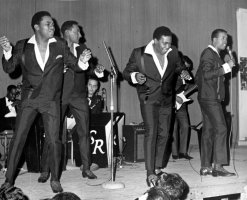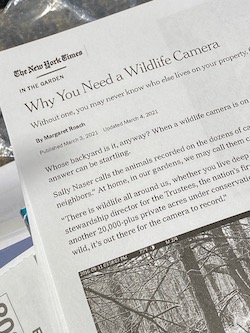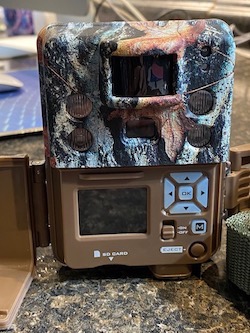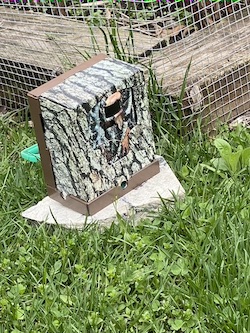It’s About The World We Live In
|
|
||
| April 22, 2021
|
 |
 |
|
|
||
NOTE: For quite a few years I’ve written about Earth Day in April of each year. This article is similar to those of the past but I’ve republished it again those of you who may not have read it previously.
For me Earth Day has been a part of my vocabulary since 1970 when I was a student at the University of Michigan. I was majoring in resource economics so naturally studying all facets of the environment was a central part of my curriculum.
Here’s some background on the origins of its observance. Wisconsin’s Senator Gaylord Nelson was a major force in organizing the first Earth Day. He wanted to focus our attention on the environment, to measure the effect that the world’s population was placing on our limited natural resources, and to implement the urgent actions to keep the earth sustainable for generations to come. Since then a generation or two has passed yet unfortunately Nelson’s urgency has not translated into the wide and responsive action that many of his disciples would have hoped.
So some 51 years later, Nelson’s intent is gaining some traction. In 2016, more than 190 member countries of the United Nations signed onto the Paris Agreement aimed at reducing greenhouse gas emissions. Formally known as the UN Framework Convention on Climate Change these nations have pledged to combat climate change worldwide. In 2020, a major setback occurred when the U.S. withdrew from the agreement per President Trump who considered the terms of the agreement to be cost prohibitive and would lead to a major loss of jobs. However following the 2020 election with a new Biden administration in place, our country has now rejoined the agreement as of February of this year and the U.S. is again a participant in this global organization.
If you will, please take a short detour with me as my mind has become unstuck in time.
The phrase “unstuck in time” comes from the pen of the my favorite author, the late Kurt Vonnegut. I recall meeting him in the late 1960’s when he was invited to be “writer in residence” at the University of Michigan (U of M).
Vonnegut often frequented the “Brown Jug Restaurant” to have coffee and to smoke cigarettes. As an aside, he claimed that smoking was the slowest form of suicide. My wife Kris, a student at the time, waitressed here and would sometimes serve him. Due to her hearing difficulty she admitted that she wasn’t a very good waitress and frustrated Vonnegut with her (lack of) service. More to the point, his stay on campus as writer in residence ended prematurely when he abruptly left saying something like: “I’m leaving Ann Arbor since I have nothing more to teach you about writing.” So it goes.
|
|
||
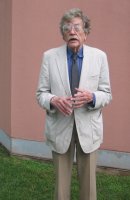 Kurt Vonnegut photo courtesy of Colleen Taber |
 the author and his dog living “60’s back to nature |
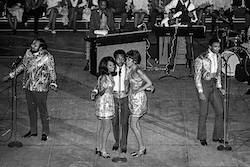 |
|
|
||
|
|
||
The 1960’s was a very vibrant and exciting, yet conflicted era. My high school yearbook quotes Charles Dickens: “it was the best of times and it was the worst of times….we were all going direct to heaven, we were all going direct the other way”. This was the period of the military draft and Viet Nam, living off the land and making peace, hippies and long hair. We were contemporaries of heavy metal, Motown, Bob Dylan, The Beatles, James Taylor and Woodstock music. With this as a backdrop, we happen upon the ENACT Teach-In at the U of M.
In the early 60s Rachel Carson published Silent Spring, a book describing the harmful effects of pesticides on the environment. Many have cited Silent Spring and the horrible 1969 oil spill near Santa Barbara as two of the impetuses for the environmental movement. In 1970 on March 11, a dedicated environmentally conscience group organized the Environmental Action for Survival (ENACT) Teach-In at the U of M to discuss, to educate and to propose solutions and laws to stem environmental problems created by the earth’s inhabitants. Speakers included Senator Nelson, ecologist Barry Commoner, Michigan Governor William Milliken and U of M President Robin Flemming.
Hoping to fill the 13,000 seat Crisler Arena, the organizers also provided entertainment by the cast of Hair (a Broadway hit show) and folk song artist Gordon Lightfoot. Among the dozen songs Lightfoot performed was the Canadian Railroad Trilogy (click for lyrics). This lengthy song is a poetic ballad describing the building of the railroads across Canada and the difficult tradeoffs between developing a strong, vibrant economy for a growing population and keeping the land pristine for the future – an apt way to describe the environmental conflict in musical terms.
The ENACT Teach-In was a success and preceded Earth Day by six weeks. On April 22, 1970 more than 2000 colleges and 10,000 primary and secondary schools participated in the Earth Day Environmental teach-in, celebratory and activism activities throughout the US.
I was planning a career revolving around conservation, ecology and recycling. I studied writings from the likes of educators and humanists Kenneth Boulding, Buckminster Fuller and E.F. Schumacher and took courses such as forestry, resource management and cost-benefit analysis.
The next year I graduated with a degree in Natural Resource Economics. Regretfully my great enthusiasm for things environmental slowly tapered off. After a year hunting for a job in this nascent field I was still unemployed. Instead, I ended up in the computer and publishing business. So it goes.
How well or how poorly have us earthlings have done to improve the environment these past 51 years? Not that long ago I read an opinion piece that details how environmental issues have bounced around for 30 years between our Republican and Democratic leaders without very much accomplished. An older NY Times article by Nathaniel Rich aptly describes political obstacles standing in the way of Earth Day goals.
In spite of the absence of political agreement to attack the environmental issues, there have been deliberate and urgent activities to resurrect many of the same or similar ideas from these earlier decades that call for a change in our lifestyles.
There have been numerous events that have flashed attention on Earth Day. This song with a conservation theme: Conviction of the Heart (click for lyrics) was performed by writer/singer Kenny Loggins at Earth Day 1995 in Washington, DC.
A few years back we took our young grandkids to see The Lorax, a movie based on a Dr Seuss’ book. It describes a place where the trees have been clear cut so there are no trees left. Everyone depends on manufactured air to provide oxygen for their survival. Through battle with “industry”, the hero finally succeeds in planting a single tree. This act restarts the path to regenerating oxygen naturally. While the story is a little far fetched, it presents the oxygen depletion issue to a young generation.
We later took them to see another movie – The Croods which depicts the struggle of a family of cave people to survive in a deteriorating world. They survive through human ingenuity with inventions such as fire, shoes and wheels. I hope this isn’t the only lesson for our next generation – that technology alone is going to save our environment. Yes, we are quite ingenious. But a lot of us have reservations that technology by itself will solve our planet’s woes.
A look at 2020 statistics shows how alternative fuel activities have affected employment in the various energy sectors. The coal industry employees about 45,000 and the more inclusive fossil fuel industry – coal, oil and natural gas – employees 570,000. The number of employees working in wind power number about 110,000 and in solar power 250,000. Additionally about 250,000 are employed in the transportation industry to develop and produce alternative fuel vehicles – natural gas, hybrids, electric and fuel cell technology. It’s pretty clear that the energy industry is now heading towards more renewables.
Photography and the Environment
As many of you know, my interests are very much aligned with photography. So you might ask “what does all of this rambling have to do photography?” I thought it might be interesting to look at photography then and now to compare their individual environmental impacts.
At first, I thought this was going to be a “no brainer” – that digital photography yields huge environmental savings compared to conventional photography. But as I began to dig deeper, I see that there are two sides to this argument.
Conventional Photography
Having worked in several commercial photo labs long before the advent of digital, I’m familiar with the processes that are used in conventional (film-based) photography.
Most conventional cameras use a cartridge or canister of film for taking 12, 20 or 36 photographs. Each “roll” of film is individually packaged for sale in hundreds of thousands of retail locations. Besides the resources needed to manufacture the film, a considerable amount more are used to market and distribute the products.
Film derives its light sensitivity from a chemical mixture of silver halide that’s coated onto its surface. After being exposed to light by the camera, the film is first “developed” – the silver halide image is converted into a metallic silver and then “fixed” – the unused silver halide is dissolved. This makes the negative image permanent. Color film requires additional chemicals to form the dyes used to reproduce the various colors. And still other chemicals are used to enhance the drying of the photographic materials. In addition to these chemicals, a large amount of water is used to rinse and clean the chemicals from the surface of the film.
Conventional photographic prints are processed similarly using a silver halide sensitive paper and chemicals to develop and fix and wash the positive images. Most commercial photo labs make prints from each exposure on a roll of film.>
The environmental impact of conventional photography is significant. A large amount materials is consumed to make film and photographic paper. A large amount of nasty and toxic chemicals are used to process both the film and prints. And an awfully large amount of fresh water is used in the process as well.
Digital Photography
At first glance, the coming of age of digital photography appears to have a beneficial impact on the environmental.
With digital, no longer is there a need for roll after roll of film. Instead a single chip (SD-card or CF-card) can capture hundreds, maybe thousands of images.
Now, these digital images no longer require chemical development. Rather, the images are immediately available to review while still in the camera. For permanence, the images can be copied to your computer hard drive for safekeeping, further enhancement and presentation.
Unlike conventional processing where each exposure is mindlessly printed by the photo lab, you can be more selective. Instead you can choose to print only the best of the best images. And it’s your choice to print them using a conventional photo process at your favorite photo lab or print them at home on your color ink-jet printer.
Regardless of which camera you’ve purchased, digital photography seems like a winner from an environmental standpoint.
The Rest of the Story
As with many things in life, digital photography has a few “gotcha’s” that cloud its environmental friendly moniker.
The upside is that digital provides big savings in resources by eliminating film, packaging, paper and chemical processing. However, digital shifts the resource burden to the manufacturing and maintaining of the personal computer. Yes, there are some who make do without a personal computer. These picture takers bring their digital film to a photo lab to make their selected prints. But most picture takers collect, organize, retouch, process and present their photographs using a personal computer.
While it’s dated, a United Nation report tells us that “the average 24 kg desktop computer with monitor requires at least 10 times its weight in fossil fuels and chemicals to manufacture, much more materials intensive than an automobile or refrigerator, which only require 1-2 times their weight in fossil fuels. Researchers found that manufacturing one desktop computer and 17-inch CRT monitor uses at least 240 kg of fossil fuels, 22 kg of chemicals and 1,500 kg of water – a total of 1.8 tonnes of materials.”
Of course a personal computer is used for other tasks as well, so it’s not fair to put the full blame for digital photography’s negative impact on the environment.
And to power all of these cameras, computers and accessories the need for electricity either from the wall outlet or batteries is climbing. Does this contribute to our CO2 footprint?
Not surprisingly, manufacturers are working feverishly to add new and amazing whiz-bang features to their cameras. But now instead of buying a conventional camera every ten years or so, the buying cycle for digital cameras is a lot more frequent. Read: more resources consumed.
Wrapping it Up
We can credit the overwhelming adoption of digital cameras for saving the environment from millions of rolls of film and the required chemicals to develop the the film and prints. In addition to the great quality of digital technology, we benefit from a huge reduction of harmful photographic chemicals.
Unfortunately, from an environmental standpoint, digital photography is a mixed bag when considering the pervasive number of new cameras and extensive use of the personal computer.
In his novel Slaughterhouse Five, Kurt Vonnegut might comment on this no-win situation with the phrase so it goes.
I while back I wrote another article that might be of interest if you’re following the status of our environment.
After all of these years as an avid photographer I’m still a proponent of carefully using our precious natural resources. Aside from photographing family, my favorite pastime is nature and landscape photography. Below you can see some of the ways that I commune with nature.
 |
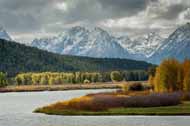 |
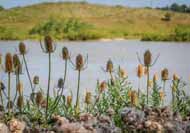 |
|
|
||
 |
 |
 |
|
|
||
 |
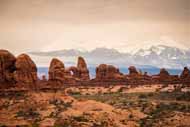 |
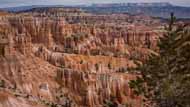 |
|
|
||
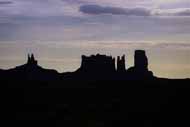 |
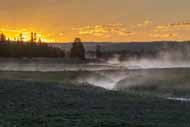 |
 |
|
|
||
 |
 |
 |
|
|
||
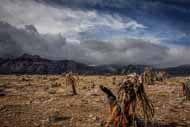 |
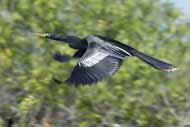 |
 |
|
|
||
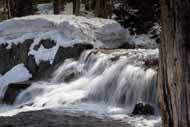 |
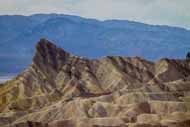 |
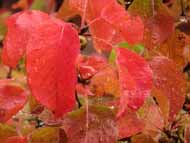 |
|
|
||
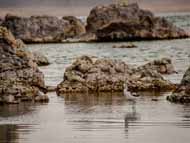 |
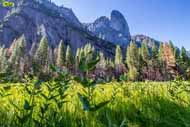 |
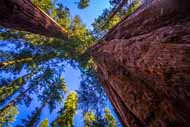 |
|
|
||
 |
 |
 |
|
|
||
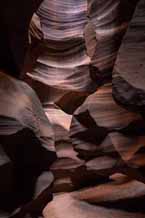 |
 |
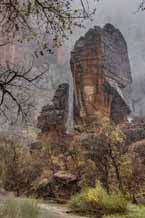 |
|
|
||
 |
 |
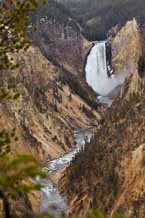 |
|
|
||
 |
These photos were taken in many of our National Parks, Monuments and parklands. As you read this, I’m off to other outdoor places to experience more of our earth. | 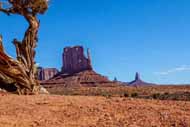 |
|
|
||
To the best of my ability I continue to practice “leave no trace photography” – disturb neither our wildlife nor its surroundings. Photography, whether conventional or digital, is a gift that lets me enjoy the wonders of our amazing world visually. I think many others agree.
I’ve long been conscientious about my “environmental footprint” – using recyclable packaging; choosing fuel-efficient vehicles; keeping our trees healthy; reducing fertilizer and pesticide usage. Individually I’m not making much of a difference but together we can really make a dent.
As for Earth Day – some believe that it is the world’s largest annual non-religious holiday with more than a billion participants.
Happy Earth Day!
More Information
Here are a few articles about Earth Day and about the conventional vs digital photography debate.
- How to Reduce Your Environmental Footprint
- How to Be an Environmentally Friendly Photographer
- Environmental impact of digital cameras compared to film
- Environmental Effects of E-Waste
- Analog vs. Digital Photography
- Reducing the Environmental Impact of Your Photography
For those of you who are interested in the movement, here is a link one of the main Earth Day sites.

History of Earth Day

Earth Day Action Site
************************************************************************
Written by Arnie Lee
Please leave your comments below or address your thoughts about this article, to Arnie via email
|
Canadian Railroad Trilogy By Gordon Lightfoot |
 |
|
There was a time in this fair land when the railroad did not run When the wild majestic mountains stood alone against the sun Long before the white man and long before the wheel When the green dark forest was too silent to be real But time has no beginnings and history has no bounds As to this verdant country they came from all around They sailed upon her waterways and they walked the forests tall And they built the mines the mills and the factories for the good of us all And when the young man’s fancy was turning to the spring The railroad men grew restless for to hear the hammers ring Their minds were overflowing with the visions of their day And many a fortune lost and won and many a debt to pay For they looked in the future and what did they see They saw an iron road running from sea to the sea Bringing the goods to a young growing land All up through the seaports and into their hands Look away said they across this mighty land From the eastern shore to the western strand Bring in the workers and bring up the rails We gotta lay down the tracks and tear up the trails Open your heart let the life blood flow Gotta get on our way cause were moving too slow Bring in the workers and bring up the rails We’re gonna lay down the tracks and tear up the trails Open your heart let the life blood flow Gotta get on our way cause were moving too slow Get on our way cause were moving too slow Behind the blue Rockies the sun is declining The stars, they come stealing at the close of the day Across the wide prairie our loved ones lie sleeping Beyond the dark oceans in a place far away We are the navvies who work upon the railway Swinging our hammers in the bright blazing sun Living on stew and drinking bad whiskey Bending our old backs til the long days are done We are the navvies who work upon the railway Swinging our hammers in the bright blazing sun Laying down track and building the bridges Bending our old backs til the railroad is done So over the mountains and over the plains Into the muskeg and into the rain Up the St. Lawrence all the way to Gaspe Swinging our hammers and drawing our pay Driving them in and tying them down Away to the bunkhouse and into the town A dollar a day and a place for my head A drink to the living and a toast to the dead Oh the song of the future has been sung All the battles have been won Oer the mountain tops we stand All the world at our command We have opened up the soil With our teardrops and our toil For there was a time in this fair land when the railroad did not run When the wild majestic mountains stood alone against the sun Long before the white man and long before the wheel When the green dark forest was too silent to be real When the green dark forest was too silent to be real And many are the dead men too silent to be real |
|
|
Conviction Of The Heart By Kenny Loggins |
|
Where are the dreams that we once had? This is the time to bring them back. What were the promises caught on the tips of our tongues? Do we forget or forgive? There’s a whole other life waiting to live when One day we’re brave enough To talk with Conviction of the Heart. And down your streets I’ve walked alone, As if my feet were not my own Such is the path I chose, doors I have opened and closed I’m tired of living this life, Fooling myself, believing we’re right I’ve never given love With any Conviction of the Heart One with the earth, with the sky One with everything in life I believe we’ll survive If we only try How long must we all wait to change This world bound in chains that we live in To know what it is to forgive And be forgiven? Too many years of taking now. Isn’t it time to stop somehow? Air that’s too angry to breathe, water our children can’t drink You’ve heard it hundreds of times You say you’re aware, believe and you care, But do you care enough To talk with Conviction of the Heart? |


